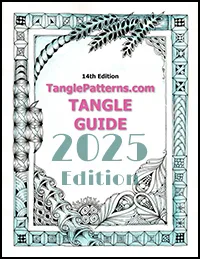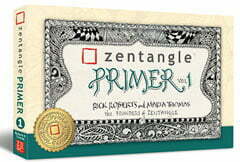“As time goes by, it is an increasing challenge to develop new tangles that are magical, simple and easy to create. … We think pea-nuckle is just such a tangle. It’s made with only two elemental strokes. One is curved; one is straight. It is simple, yet its result is surprising.” ~ Rick Roberts, co-founder of Zentangle® along with his soulmate and artist and calligrapher extraordinaire, Maria Thomas.
“Ornamental pattern-work, to be raised above the contempt of reasonable men, must possess three qualities: beauty, imagination, and order.” ~ William Morris
TanglePatterns is about Zentangle® and the Zentangle Method™. For TanglePatterns I seek tangles of excellence that meet the standards set by Zentangle and keeping within their original intention for this art form. My goal for TanglePatterns has always been to showcase only the BEST tangles.
Not all tangles.
Only the best. The tangles that are “magical, simple and easy to create.” Tangles of elegance and simplicity. Non-representational patterns of repetitive stokes that are easy to teach and offer everyone of all ages a high degree of success in tangling.
I’m sure you can appreciate why “the rules” are important to this wonderful art form, and why I endeavor to uphold the standards Rick and Maria expect of all CZTs.
When I started TanglePatterns in 2010, I wasn’t a CZT yet but I studied closely every single word on zentangle.com, in my Official Zentangle Kit, and on the Zentangle blog and made an effort to stick as close to my understanding of Rick and Maria’s original intention of the Zentangle Method™ as possible.
I became a CZT the following year (October 2011, CZT#7) and the day after the seminar I spent time with Maria at her home discussing exactly what makes a tangle for her, and what does not.
Before I added the “A pattern is not always a tangle” page to the site, I created a document and sent it to Maria for review to make sure I was correct about the qualifications.
I also consult with her on occasion seeking guidance on patterns submitted for consideration that I wasn’t planning to use and making sure I was on solid ground in my decision about why they didn’t qualify. Thus I have a pretty clear picture from the horse’s mouth, as it were (apologies Maria), of what is considered a tangle for Zentangle.
This means there were a few patterns already posted on TanglePatterns that in hindsight wouldn’t be considered tangles for Zentangle. Maria noted that very early on they too included some tangles “that are on the edge, such as pokeroot, but that was way at the beginning and we have tried to keep the tangles as little like ‘drawing something’ as possible. One simple stroke in many places, then a different stroke next to the others…etc.”
Every pattern that is sent to me or I’ve located online is given careful consideration.
But the fact is that many patterns published online or submitted to TanglePatterns don’t meet the criteria of a tangle. [Unfortunately there are also many patterns in books published by CZTs and online too that do not qualify as tangles, or as new tangles.]
These are some of the reasons a pattern will not be published on TanglePatterns:
1. It’s a drawing of some thing
Tangles are non-objective and abstract, repeating strokes. Non-representational.
2. It’s a motif that has to be repeated to fill a space, rather than an overall pattern
As Maria described to me, a tangle isn’t a repetition of a drawing, it’s a repetition of a stroke. As she points out in the IDOZ 2025 video, “If it didn’t repeat, you would be drawing.“
Many times a pattern is a single motif, which makes the pattern something to draw, rather than an overall, organically growing tangle. Floral or medallion-type patterns usually fall into this category.
“Many of our tangles are only one or two strokes that repeat over and over. We put a lot of time and thought into deconstructing familiar and seemingly complex patterns down to their essentials. This allows you to get into Zentangle’s process without trying to draw something.” ~ Zentangle Blog
3. It begins with pencil grids or guidelines – including a pre-planned string
If a pattern begins by planning with pencil grids or guidelines of some type it is not a tangle.
A tangle “has to be done without any underlying pencil structure or preplanned [pencil] grid.” (From the Zentangle blog.)
Zentangle is a “structured method of putting pen to paper with no expectation. This helps you deliberately shift your state of mind from distraction to relaxed focus, from anxiety to calm.” (From The Book of Zentangle)
Pencil = expectation of a certain result. [Note: This is not the same as using the penciled Zentangle String à la Purk or Zander, for example, where the tangle takes advantage of the shape of the section to form the pattern. However, “planning” a string in advance in order to draw a certain pattern clearly goes against the “no expectation” basis of Zentangle.]
4. The steps have been drawn using a ruler (or some type of template, stencil, etc.) .. or, heaven forbid, they’re digitally created images
“Just as we point out that there’s no eraser in a Zentangle Kit, there’s also no ruler. … With a relaxed focus and leaving rulers and preconceived notions aside, expect to be surprised and delighted.” ~ Zentangle blog
No rulers in Zentangle. Even if the pattern would otherwise be considered a tangle I don’t publish them because there are no rulers in Zentangle and it sets a misleading example when ruled or otherwise “assisted” strokes appear in the steps.
As Zentangle is all about you and your Micron, digitally drawn steps are not acceptable for TanglePatterns.
5. The steps are drawn on graph or dot grid paper
This is fine for practicing but not for demonstration purposes. For one thing this suggests that perfection is required. Again, expectation.
6. It’s not unique
The pattern isn’t particularly unique or its too similar to another tangle already published here or elsewhere.
This occurs frequently and I do try very hard not to duplicate similar tangles on the site. Adding an aura or two to an existing tangle doesn’t usually make a new tangle.
Usually I put the pattern in question into a “holding” archive to be reviewed at a future date to see if I still have the same view. Duplicates do not get published unless I’ve had a senior moment and, fingers crossed, that hasn’t happened yet.
I admit to an aversion to ego-based tangle names. It doesn’t seem very Zen-like to name a tangle after oneself especially when there’s a universe of potentially great tangle names available.
7. Too many steps
The pattern requires too many steps and/or written instructions (tangles are simple and easy to create, see the quote in #2 above). Complex instructions turn a pattern into “something to draw”.
A fine tangle does not require written instructions, the few simple visual steps will “say” it all.
Complex patterns require thinking about how to build them and not readily allowing one to get into the “unthinking” rhythm of a Zentangle experience. Simple tangles are the Zen of Zentangle.
8. Not elegant or magical enough
Or plain and simple, the pattern isn’t as elegant, interesting or aesthetically pleasing as others under consideration.
There are always exceptions of course. For instance there are occasions when a pattern isn’t necessarily elegant or amazing or different, but I add it because the story behind it makes it worth sharing.
9. Presentation counts
Self explanatory. Plus I don’t link to Facebook, Instagram or galleries of patterns.
To qualify, a tangle must have its own unique URL or the steps submitted for publication on TanglePatterns.
10. And every now and again, I’ve just plain forgotten about a submission
It’s happened once or twice {wink}. Occasionally if I receive many submissions at once or it’s received during a holiday or vacation period, a submission can get lost in the shuffle. My procedure is to enter each submission in a database file and then I create a document of every pattern received. Then I work from those printouts to test each pattern. If somehow a pattern doesn’t get printed out, it can get overlooked.
However I regularly review my digital files of all eligible submissions. This is how I locate a tangle that might have been overlooked.
TanglePatterns.com is about Zentangle and showcases only the best tangles.
Anything that doesn’t meet the standards of the Zentangle Method is not eligible for publishing on TanglePatterns.
“A pattern is not always a tangle.”
|
.oOo. |
|
Enhance your Zentangle experience while supporting TanglePatterns: |
|
CURRENT EDITION! TanglePatterns.com TANGLE GUIDE, 2025 Edition |
|
 |
The 14th Edition of the TanglePatterns.com TANGLE GUIDE is an instant-download 117-page interactive digital eBook/PDF containing over 2,000 tangles on the site from May 2010 through December 31, 2024. It's a great resource and a must-have digital tool for using the site. Visit the STORE > E-BOOKS page and help keep TanglePatterns.com going by getting your copy now! |
|
"Linda, Thank you! I was relying on too few and getting stuck after 3 years of daily working with Zentangle. This has inspired me to ‘begin again’ with renewed excitement." ~ Barbara R. |
|
| See the BOOK REVIEWS page for more details on its features and view a sample page. Note: this is a digital product you download immediately when you place your order, nothing will be physically mailed to you. | |
| If you're new to Zentangle® and tangling, my TanglePatterns.com BEGINNER'S GUIDE TO ZENTANGLE is just what you need to get started. Also available en Français and en Español. | |
|
|
|
 |
This is the only Zentangle book you'll ever need: the fabulous Zentangle PRIMER Vol 1. It's your CZT-in-a-book by the founders of Zentangle®. Visit the STORE tab on the top menu bar or click on the image. For more about the content and to read the rave reviews, visit the BOOK REVIEWS tab. |
| Now available in KINDLE format for $9.99. Spanish Edition here. Japanese Edition here. | |
| "Absolutely the best Zentangle Book yet! As an accomplished artist I used to think I did not need instruction on this art form. How wrong I was! My tangling improved by leaps and bounds after reading this book. If you think you have Zentangle down then you need this book more than ever!" ~ Kris H | |
|
|
|
|
.oOo. |
|








RECENT COMMENTS